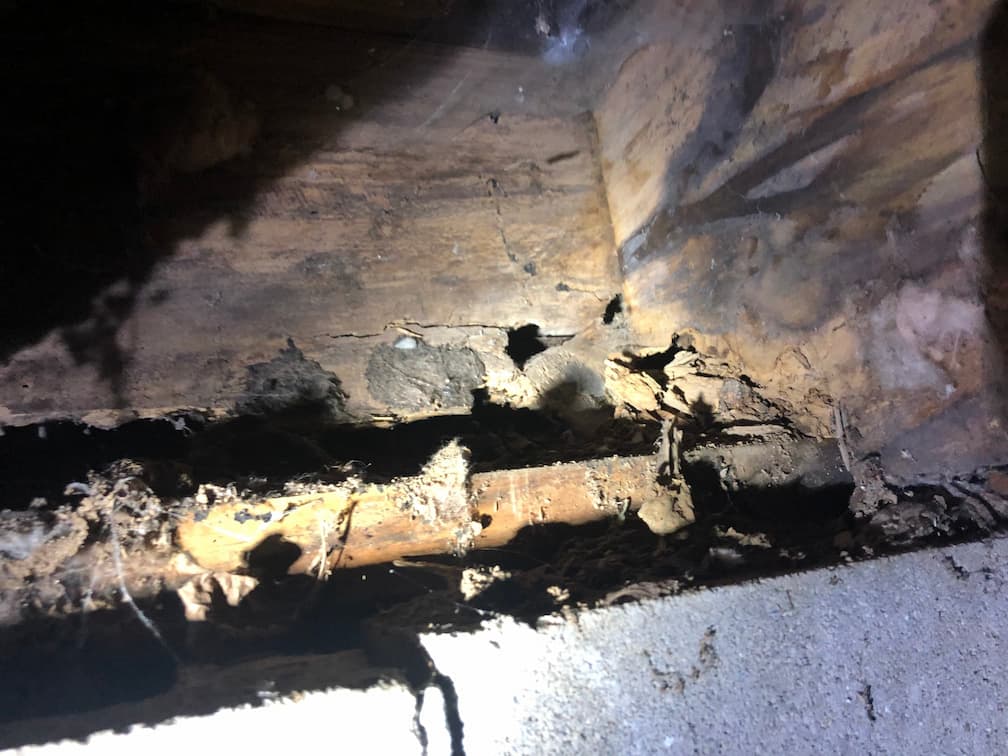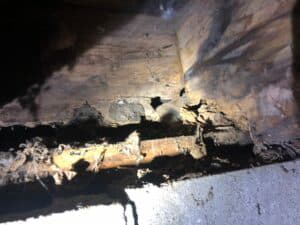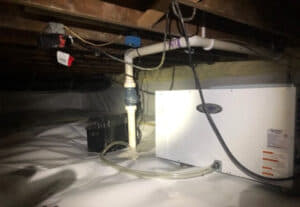How To Treat and Prevent a Flooded Crawl Space

Originally posted 10/7/19, updated 8/20/21
You’re a good homeowner. You change your furnace filters, schedule maintenance for your HVAC, test the batteries in your smoke and carbon monoxide detectors, keep your insurance current, you name it, you do it! But what about your crawl space? Do you perform any sort of annual or seasonal maintenance in that dark and gloomy place below the floorboards?
If your answer is “no,” you’re not alone. A crawl space is easy to ignore- or forget about entirely- until it becomes a problem. Acculevel is a family-owned and operated company that specializes in foundation repair and waterproofing. We’ve repaired many, many overlooked crawl spaces since our start in 1996. Overall, we’ve helped more than 30,000 homeowners restore health and stability to their homes.
We understand that your crawl space is probably an afterthought; the old saying, “out of sight, out of mind,” is an accurate one. But we know that it shouldn’t be, because your crawl space has a tremendous impact on the health of you and your home. We’re going to explain how and why your crawl space is important, and how you can best prevent or repair a flooded crawl space.
Why Is My Crawl Space Important?
It may seem like a useless gap between your floor and the ground, but it does have functional use. For most homes, your crawl space is where your utilities are accessed by tradespeople. Plumbers, electricians, HVAC specialists- all of them will use your crawl space to upgrade or repair your home.
Your Crawl Space Affects Your Health
Your crawl space has a significant impact on the health of your home. Up to 40% of the air you breathe in your house originates in your crawlspace. So if your crawl space is in poor condition, it could be causing health problems for you and your family.
 This photo was taken by an Acculevel project advisor during a free estimate appointment. There is significant rot on these joists.
This photo was taken by an Acculevel project advisor during a free estimate appointment. There is significant rot on these joists.
Your Crawl Space Affects Your Home’s Health
It’s extremely likely that your crawl space “floor” is actually the dirt below your home. This means moisture can easily enter your crawl space from the ground, as well as through any cracks or fissures in your foundation. Your crawl space doesn’t have to have standing water in it to be an issue.
Any moisture lingering in the space will quickly become a costly problem if you ignore it. A wet crawl space provides a damp, humid environment- and this is not good for your home. The wooden components of your floor (joists, beams, sill plate, etc) will begin to rot. Damp wood and moist air is the ideal environment for hazardous biological growth, insect habitats, and eventually will lead to foundation decay. The number one cause of sagging floors is moisture damage.
How to Protect Your Crawl Space from Water Intrusion
Because water can enter the crawl space from the ground up, there’s no guaranteed way to keep your crawl space dry without full encapsulation (we’ll talk about this later). But there are a number of things you can do to reduce water intrusion.
What You Can Do:
Start with your guttering. You probably do this at least twice a year, in the spring and fall. But you also need to inspect the guttering itself. Make sure it’s in good condition, remove any blockages from leaves or other debris, and check the connections. Replace any sections that are damaging or rusting.
Follow up with the downspouts. Where is the water going when it leaves the guttering? If your downspouts are in poor condition, or too short, the water is draining next to your foundation. Water next to your foundation is going to eventually seep into your foundation and then into the crawl space.
We recommend that your downspouts drain at least 10 feet away from your foundation. Downspout extensions are an excellent DIY project, if you are so inclined.
Maintain or Improve Your Grade. The ground around your home should not be perfectly level. It should be graded, or sloped, slightly down and away from your home in all directions. This encourages rainwater to naturally drain and flow away from your home.
If the grade has flattened, you’ll probably want to work with a landscaping company to restore the appropriate grade. A good landscaper can also help you evaluate the flower beds and decor of your yard, to determine if any are planted or placed too close to your home. Plant roots can damage your foundation, and some decor will trap or hold moisture.
What You Will Need a Pro to Do:
Assess Your Crawl Space. Are your floors beginning to sag? Is there a musty smell coming up from the crawl space? Do you suspect there’s been water in your crawl space before? If you have any concerns about the health and stability of your home, you should have a foundation contractor evaluate your crawl space and foundation. Most repair companies offer free assessments or inspections, and will help you determine what actions (if any) you should take.
In general, damp crawl spaces should be waterproofed. There is a specific type of water drainage, called GeoChannel, that is designed to work in crawl spaces. It’s surrounded by fibers that filter out dirt and debris, to prevent any clogs from forming. Water drainage should be routed to a sump pump, which will expel the water out of the crawl space through a discharge line. At Acculevel, we always install a battery back-up with our sump pumps, to protect our customers in the event a power outage occurs.
 This photo was taken by an Acculevel crew member, after waterproofing a customer’s crawl space. Pictured is the sump pump, battery back-up, and discharge line.
This photo was taken by an Acculevel crew member, after waterproofing a customer’s crawl space. Pictured is the sump pump, battery back-up, and discharge line.
The ideal solution for a wet crawl space is encapsulation. This process starts with waterproofing, then adds full coverage of the crawl space (walls & floor) with a heavy-duty liner that keeps all moisture out of the crawl space. The encapsulation liner Acculevel uses is a polyurethane membrane interlaced with high-density fibers. This material is inorganic, so it won’t support any biological growth. It is also the strongest and most puncture-resistant available in the market.
The encap liner is sealed around the perimeter with spray foam insulation, which repels water and seals every gap perfectly. Spray foam is far superior to the fiberglass insulation typically used in a crawl space; your HVAC system should run more efficiently (and less often) with spray foam insulation. A whole-home dehumidifier is the final piece to encapsulation. Once your crawl space is fully encapsulated, you will have a clean and dry space that you can use for storage, if you like.
 This photo was also taken by an Acculevel crew member. This crawl space has been encapsulated; the dehumidifier’s drainage line empties directly into the sump pump, eliminating the need to empty a dehumidifier tank.
This photo was also taken by an Acculevel crew member. This crawl space has been encapsulated; the dehumidifier’s drainage line empties directly into the sump pump, eliminating the need to empty a dehumidifier tank.
What Should You Do if Your Crawl Space Floods?
You need to get the water removed as soon as possible. If you are able to do this yourself, that’s great! But many homeowners cannot or will not enter their crawl, so hiring a handyman or general contractor is often the best option.
Once the standing water is removed, your crawl space can be evaluated by a reputable professional contractor like Acculevel. The contractor should meet with you to determine what concerns you have, a little history about your home, and what your goals are. Then they should perform a full inspection of your home and crawl space, to help you determine what the best course of action is.
Want to Learn More about Crawl Space Repairs?
If you need additional information on water intrusion, sagging floors, foundation problems, repair methods, and costs, you should have our ultimate homeowners guide. This free resource is regularly updated with the latest information we have, and organized in a way that allows you to select the specific areas that interest or concern you.
Has Your Crawl Space Flooded Recently?
If you want to schedule a free estimate now, call Acculevel @ 866-669-3349. You can also complete our online form, and have us contact you by phone, text or email you to schedule an appointment with one of our expert project advisors. We service Indiana and the surrounding areas, and have recently extended our coverage to the Cincinnati, OH region.
Outside of our service area? Let us help you by suggesting ways to find a good contractor, and providing you with a list of questions you should ask a contractor before signing an agreement of any type.

